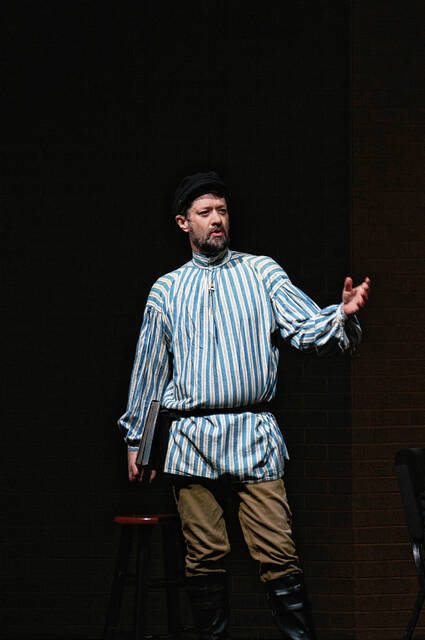
Columbus actor John Johnson narrates “Peter and the Wolf” during the Columbus Indiana Philharmonic concert Saturday.
Photo provided by Tim Miller
The Columbus North Erne Auditorium was bustling with excitement Saturday afternoon. I don’t know if I have ever seen such a diverse audience — infants, children, and adults of all ages from many walks of life — as the Columbus Indiana Philharmonic staged a truly intergenerational experience.
As the lights dimmed and the orchestra tuned, it soon became evident that this was not just a children’s concert, but a “learners” performance for all ages. Each and every nuance of the event was led by the teacher and conductor of the day, artistic director David Bowden. It reminded me so much of the early Leonard Bernstein “Young Peoples Concerts”, which weren’t just for young people at all.
The concert began with the “Carnival of the Animals” by Camille Saint-Saens. This incredible composition of 14 movements describes various animals and features two piano soloists — in this case, Charles Webb and Steven Mann, each performing with incredible dexterity and nuance.
What impressed me most, however, was the freedom Bowden gave the musicians to be musical. It truly felt like a chamber music experience. In one moment, the pianos are playing the sounds of the elephant with the bass section behind them, and in another, the orchestra playing the “cuckoo” with the clarinet in the very back of the hall (congratulations Samantha Johnson-Helms).
One of the real thrills for me was hearing the swan played so eloquently by principal cellist William Cayanan. Bowden simply stepped aside and let the pianists and cellist make beautiful music together. Might I mention in a side note that my dear friend and former dean, Charles Webb, played beautifully, and as he left the stage, it was announced that he is 89! Can you imagine? What a treasure he is to the musical culture of our region! This work really showcases what enormous contrast in color, style and articulation can be attained with a well-trained orchestra.
Very cleverly, while the pianos were being moved and the stage reset, Bowden brought out members of the orchestra to demonstrate seven of the wind instruments that they would be hearing later in the concert. The audience not only learned about the instruments but was introduced to the thematic material to come later in the concert with Peter and the Wolf.
Second on the program was the “Harry Potter Symphonic Suite.” This didn’t require much explanation as all the Harry Potter fans could recognize the familiar movie material. Here the orchestra displayed its comfort and command of the symphonic idiom. From the challenging string writing in the opening section to the glorious brass ensemble sounds, John Williams is a master of orchestration. I was captivated by the beauty of his melodic lines.
“Peter and the Wolf,” by Sergei Prokofiev, is not only a children’s story, it is a study in the notion of “leitmotif”. Each principle character in the story has its own identifying melody and instrument. Not only does the work tell a story with a happy ending, through the process we learn the identity of various instruments. The work has a narrator, which in this case was carried off beautifully by Columbus’s own John Johnson, cleverly dressed in Russian garb. While the storytelling appears to be quite natural, it is actually very challenging, because the narration must be carefully integrated into the score like pieces in a puzzle. Each character was portrayed with excellence, particularly the wolf, played by the horns, and the grandfather played by bassoons.
Before the last piece, Bowden took the time to talk to the audience and especially the parents of the children about the importance of “making music.” He emphasized the importance of starting early. As evidenced by Webb, music is an enrichment experience that can last a lifetime. It not only enhances our life but keeps our minds alert longer. Bowden’s passion and sincerity is stellar and rises above the norm of most orchestra conductors. His demeanor on the podium speaks volumes about his integrity as both a conductor and educator.
The concert concluded with the wonderfully familiar “Sorcerer’s Apprentice” by Paul Dukas. From the spellbinding pianissimo in the beginning to contrasting episodes of dancing, the orchestra’s articulation and dynamic contrasts led us through the images of dancing brooms and sorcery. In fact, the audience was led into the story so well, that I noticed as the music climaxed with the sorcerer stopping the broom, a child near me said out loud; “What Happened?” … clear evidence the child was thoroughly engaged in the music.
One of the things I noticed and loved was the positioning of the winds and percussion on risers. In a concert, not only is it fun to hear the sounds, it is entertaining to see who is making them. The setup of the orchestra not only gave aural clarity and great balance, it also contained visual interest as well. It was so nice to get a great view of the excellent percussion section along with the full brass and woodwinds. Columbus should be very proud of this orchestra. As a guy with trained ears, I can say, the afternoon was a delight.
Henry Leck is a professor emeritus at Butler University. Send comments to [email protected].




